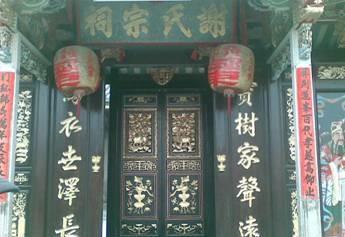(Source: Baoshu Family, only do learning and sharing, copyright belongs to the original author, hereby acknowledgement, if there is infringement, immediately delete)
Bao Shu's family is far away, and the Wuyi World is long

The ancestor of the Waisha Xie Clan Ancestral Hall is called Xie Bingsheng, Tan Hongyuan, born in the Yongle period (about 1412 AD), from about 1435 to 1460 from Min into Haiyang Waisha, when the outer sand was still barren land, thorny beings, ditch harbors, sand dunes Jingen, Hongyuan Gong to later, build embankments, repair water conservancy, open up land and start a business, and open up from the sand hilly land to the sea.
The ancestral hall was built about 160 years ago when Hongyuan Gong came to Waisha Kaiji, and was later destroyed by a strong typhoon during the Shunzhi period and the Kangxi Repulsion, and has been rebuilt for more than 250 years during the Qianlong period.
According to legend, in the second to eighth years of the Kangxi Dynasty, the tribes were forcibly driven to the Chaozhou area, and then approved the relocation after being asked by the Governor of Zhou, and at this time the descendants of the Xie clan began to reclaim the southern coast and cross southeast Asia in the south, so that thailand, Malaysia, Singapore, Vietnam, Hong Kong and several surrounding areas were all relocated from Waisha.
Nowadays, the descendants of Hongyuan have been passed down to 30 generations, and according to incomplete statistics, the descendants of Hongdao have exceeded 100,000 at home and abroad, and the ancestral hall was rebuilt in 1997.
In the 1930s, a large number of villagers in The Village of Shapeng Zhongxiang and Xinxi Southwest Village in Chenghai at that time crossed the ocean to make a living in the Nanyang area in order to survive.
For decades, the wai Xie villagers still hold their hometown in their hearts, especially after the reform and opening up of the Chinese mainland, they send representatives back to their hometowns every year to participate in the large-scale ancestor worship activities held by xie on September 15 of the lunar calendar.
Xie Shaoqing, 68-year-old chairman of the Xie Baoshu Family Association in Chenghai, Thailand, said that since 1991, the association has organized the return of thai villagers to worship their ancestors, and this has never been interrupted every year.
Nearly 50 descendants of the Xie Family Association of The Overseas Sand Township of Chenghai, Thailand and the Shantou Descendants of the Seiji Choi Xie Clan Association of Selangor, Malaysia, are looking for roots and ancestors in Shantou, Guangdong Province, looking for changes in their hometowns and looking for investment opportunities.
According to Xie Shaoqing, 68 years old president of the Xie Family Association in Chenghai Overseas Sand Township, Thailand, xie shaoqing said: In the past, returning to the hometown was a simple worship of ancestors, but now the development of the hometown is getting better and better, and many young people have also joined the group of relatives and plan to return to their hometown to invest and develop.
More than half of the more than 50 people who will return to their hometowns in Chenghai, Thailand, are born in Thailand, and more than 10 of them are returning home for the first time. Their hometown sounds are still the same, and their living habits at home also maintain Chaoshan characteristics.
Mr. Xie Shaoqing said that no matter how many years he has been in Thailand, his roots are still in Shantou, and this kind of thinking has been passed down from the older generation to the second or third generations, and will continue to be passed on in the future.
Thailand, Malaysia and New Zealand are the most important settlements of overseas hipsters, and according to incomplete statistics, there are more than 10 million hipsters and descendants living in the three places.
For a long time, the vast number of Chaoshan Chinese and overseas Chinese in Thai and Other Southeast Asian countries have lived in harmony with local residents, and while making important contributions to local economic and social development, their own undertakings have also been developed.
At the same time, the Chao villagers maintain close contact and exchanges with their hometowns, and enthusiastically pay attention to and support Shantou's economic construction and social welfare undertakings.